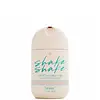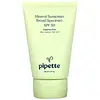What's inside
What's inside
 Key Ingredients
Key Ingredients

 Benefits
Benefits

 Concerns
Concerns

 Ingredients Side-by-side
Ingredients Side-by-side

Zinc Oxide 20.5%
Cosmetic ColorantAloe Barbadensis Leaf Juice
Skin ConditioningButyloctyl Salicylate
Skin ConditioningButyrospermum Parkii Oil
EmollientC12-15 Alkyl Benzoate
AntimicrobialCamellia Sinensis Leaf Extract
AntimicrobialCaprylhydroxamic Acid
Caprylic/Capric Triglyceride
MaskingCarbomer
Emulsion StabilisingCeramide AP
Skin ConditioningCeramide EOP
Skin ConditioningCeramide NP
Skin ConditioningCholesterol
EmollientCucumis Sativus Fruit Extract
EmollientDihydromyrcene
PerfumingDiisostearoyl Polyglyceryl-3 Dimer Dilinoleate
EmollientDimethicone
EmollientEthylhexyl Methoxycrylene
Skin ConditioningEthylhexyl Olivate
Skin ConditioningEthylhexylglycerin
Skin ConditioningFerulic Acid
AntimicrobialMelozone
PerfumingGlycerin
HumectantGossypium Herbaceum Seed Oil
Skin ConditioningHexyl Cinnamal
PerfumingHyaluronic Acid
HumectantIsododecane
EmollientMagnesium Sulfate
Methyl Octine Carbonate
PerfumingNiacinamide
SmoothingPassiflora Edulis Seed Oil
EmollientPhenoxyethanol
PreservativePhytosphingosine
Skin ConditioningPolyglyceryl-3 Oleate
EmulsifyingPolyglyceryl-4 Diisostearate/Polyhydroxystearate/Sebacate
EmulsifyingPolyglyceryl-4 Isostearate
EmulsifyingPolyhydroxystearic Acid
EmulsifyingScentenal
PerfumingSodium Benzoate
MaskingSodium Gluconate
Skin ConditioningSodium Lauroyl Lactylate
EmulsifyingSqualane
EmollientSr-Hydrozoan Polypeptide-1
HumectantTocopherol
AntioxidantTriethoxycaprylylsilane
Undecane
EmollientWater
Skin ConditioningXanthan Gum
EmulsifyingZinc Oxide 20.5%, Aloe Barbadensis Leaf Juice, Butyloctyl Salicylate, Butyrospermum Parkii Oil, C12-15 Alkyl Benzoate, Camellia Sinensis Leaf Extract, Caprylhydroxamic Acid, Caprylic/Capric Triglyceride, Carbomer, Ceramide AP, Ceramide EOP, Ceramide NP, Cholesterol, Cucumis Sativus Fruit Extract, Dihydromyrcene, Diisostearoyl Polyglyceryl-3 Dimer Dilinoleate, Dimethicone, Ethylhexyl Methoxycrylene, Ethylhexyl Olivate, Ethylhexylglycerin, Ferulic Acid, Melozone, Glycerin, Gossypium Herbaceum Seed Oil, Hexyl Cinnamal, Hyaluronic Acid, Isododecane, Magnesium Sulfate, Methyl Octine Carbonate, Niacinamide, Passiflora Edulis Seed Oil, Phenoxyethanol, Phytosphingosine, Polyglyceryl-3 Oleate, Polyglyceryl-4 Diisostearate/Polyhydroxystearate/Sebacate, Polyglyceryl-4 Isostearate, Polyhydroxystearic Acid, Scentenal, Sodium Benzoate, Sodium Gluconate, Sodium Lauroyl Lactylate, Squalane, Sr-Hydrozoan Polypeptide-1, Tocopherol, Triethoxycaprylylsilane, Undecane, Water, Xanthan Gum
Zinc Oxide 20%
Cosmetic ColorantWater
Skin ConditioningCaprylic/Capric Triglyceride
MaskingSqualane
EmollientGlycerin
HumectantCetearyl Alcohol
EmollientMethyl Dihydroabietate
Sorbitan Olivate
EmulsifyingCetyl Palmitate
EmollientCoco-Glucoside
CleansingEthyl Ferulate
AntioxidantCaprylyl/Capryl Glucoside
CleansingLecithin
EmollientBisabolol
MaskingPhysalis Angulata Extract
Skin ProtectingXanthan Gum
EmulsifyingAcacia Senegal Gum
MaskingSodium Gluconate
Skin ConditioningIsostearic Acid
CleansingPolyhydroxystearic Acid
Emulsifying1,2-Hexanediol
Skin ConditioningPolyglyceryl-3 Polyricinoleate
EmulsifyingHydroxyacetophenone
AntioxidantCaprylyl Glycol
EmollientZinc Oxide 20%, Water, Caprylic/Capric Triglyceride, Squalane, Glycerin, Cetearyl Alcohol, Methyl Dihydroabietate, Sorbitan Olivate, Cetyl Palmitate, Coco-Glucoside, Ethyl Ferulate, Caprylyl/Capryl Glucoside, Lecithin, Bisabolol, Physalis Angulata Extract, Xanthan Gum, Acacia Senegal Gum, Sodium Gluconate, Isostearic Acid, Polyhydroxystearic Acid, 1,2-Hexanediol, Polyglyceryl-3 Polyricinoleate, Hydroxyacetophenone, Caprylyl Glycol
 Reviews
Reviews

Ingredients Explained
These ingredients are found in both products.
Ingredients higher up in an ingredient list are typically present in a larger amount.
This ingredient is an emollient, solvent, and texture enhancer. It is considered a skin-softener by helping the skin prevent moisture loss.
It helps thicken a product's formula and makes it easier to spread by dissolving clumping compounds.
Caprylic Triglyceride is made by combining glycerin with coconut oil, forming a clear liquid.
While there is an assumption Caprylic Triglyceride can clog pores due to it being derived from coconut oil, there is no research supporting this.
Learn more about Caprylic/Capric TriglycerideGlycerin is already naturally found in your skin. It helps moisturize and protect your skin.
A study from 2016 found glycerin to be more effective as a humectant than AHAs and hyaluronic acid.
As a humectant, it helps the skin stay hydrated by pulling moisture to your skin. The low molecular weight of glycerin allows it to pull moisture into the deeper layers of your skin.
Hydrated skin improves your skin barrier; Your skin barrier helps protect against irritants and bacteria.
Glycerin has also been found to have antimicrobial and antiviral properties. Due to these properties, glycerin is often used in wound and burn treatments.
In cosmetics, glycerin is usually derived from plants such as soybean or palm. However, it can also be sourced from animals, such as tallow or animal fat.
This ingredient is organic, colorless, odorless, and non-toxic.
Glycerin is the name for this ingredient in American English. British English uses Glycerol/Glycerine.
Learn more about GlycerinPolyhydroxystearic Acid is a soft wax made from castor oil.
It is is a texture thickener, emulsifier, and film-former. Emulsifiers prevent ingredients from separating, such as oils and waters.
Polyhydroxystearic Acid may not be fungal acne safe.
Learn more about Polyhydroxystearic AcidThis is the synthetic salt of gluconic acid, a form of PHA and mild exfoliant.
It is mainly used to stabilize oil and butter formulations from going bad. Sodium gluconate is a humectant, pH regulator, and chelating agent.
Chelating agents help neutralize unwanted metals from affecting the formulation.
Sodium gluconate is water-soluble.
Learn more about Sodium GluconateSqualane is an emollient that helps the skin hold onto moisture. It's an oily liquid that occurs naturally in certain types of fish and plant oils.
Because squalane boosts hydration in the skin, it also comes with plenty of benefits: it is an antioxidant and can help fight free radicals and skin damage. Squalane is also found to have a detoxifying effect when applied.
Squalane comes from squalene, which occurs naturally within the sebum of our skin. It is one of the oils our skin produces to keep itself hydrated. Squalane is the hydrogenated version of squalene and has a longer shelf life.
Research shows that squalane is non-irritating (even at 100% concentration).
In general, it's a fantastic ingredient. It does a great job at hydrating the skin, and it's suitable for those with sensitive skin.
The source of squalane may impact malassezia / fungal acne. This is because olive oil derived squalane can contain impurities such as fatty acids and plant waxes. Sugarcane derived squalane is recommended for anyone with malassezia concerns.
Is squalane vegan?
This depends on the source. Squalane can be derived from both plants and animals. Most squalane used in skincare comes from plants.
Please note: the source of squalane is only known if disclosed by the brand. We recommend reaching out to the brand if you have any questions about their squalane.
Read more about squalene with an "e".
Is squalane an oil?
Squalane is often called an oil, but it’s technically not; it’s a hydrocarbon, meaning it’s only made of carbon and hydrogen, unlike true oils which are triglycerides made of fatty acids and glycerol.
The term “oil-free” isn’t regulated, so companies can define it however they want. Some exclude all oils, while others just avoid mineral oil or comedogenic oils.
While some people avoid oils thinking they cause breakouts, the right kind of oil (or oil-like ingredient like squalane) can actually help balance and hydrate your skin. It’s worth testing out simple oils or squalane to see what works best for your skin.
Learn more about SqualaneWater. It's the most common cosmetic ingredient of all. You'll usually see it at the top of ingredient lists, meaning that it makes up the largest part of the product.
So why is it so popular? Water most often acts as a solvent - this means that it helps dissolve other ingredients into the formulation.
You'll also recognize water as that liquid we all need to stay alive. If you see this, drink a glass of water. Stay hydrated!
Learn more about WaterXanthan gum is used as a stabilizer and thickener within cosmetic products. It helps give products a sticky, thick feeling - preventing them from being too runny.
On the technical side of things, xanthan gum is a polysaccharide - a combination consisting of multiple sugar molecules bonded together.
Xanthan gum is a pretty common and great ingredient. It is a natural, non-toxic, non-irritating ingredient that is also commonly used in food products.
Learn more about Xanthan GumZinc Oxide is a mineral broad-spectrum UV filter; it is the broadest UVA and UVB reflector approved by the FDA. It also has skin protectant and skin soothing properties.
Zinc oxide is one of the most effective broad-spectrum UV filters. It protects against UVB, UVAII, and UVAI. In comparison to its counterpart titanium dioxide, zinc oxide provides uniform and extended UVA protection.
Another great benefit? This ingredient is highly photostable so it won't degrade easily under sunlight.
A common myth is that mineral UV filters are widely believed to primarily reflect UV light.
However, modern research shows titanium dioxide absorbs UV radiation like chemical filters (~95% absorption & 5% reflection).
Zinc oxide has great skin soothing properties so you'll likely find this in sunscreens formulated for sensitive skin or babies/children. It is unlikely to cause "eye sting" like other sunscreen ingredients.
Regulatory agencies consider zinc oxide to be non-toxic and safe. It has also been shown to not penetrate the skin.
Unfortunately, this ingredient does leave a visible white cast. This is why mineral sunscreens are often less cosmetically elegant than chemical or hybrid ones.
In cosmetics, zinc oxide can be found in both non-nano and nano-sized forms. The nano version is used to reduce white cast and improve the texture of sunscreen formulas.
There are ongoing concerns surrounding nano-zinc oxide's impact on marine ecosystems and whether it can be absorbed into skin.
Regarding marine ecosystems and coral reefs, there is no conclusive evidence that any form of zinc oxide (or any other sunscreen ingredients) will cause harm. The science is still developing but many consumers are keeping a close eye on this issue.
Please note, many destinations have reef-safety sunscreen rules. For instance, the U.S. Virgin Islands advises all visitors to use non-nano mineral sunscreens.
There has also been some stir about whether micronized or nano zinc oxide has potential photoxicity and absorption through the skin/lungs.
An in-vitro (done in a test tube or petri dish) study demonstrated micronized zinc oxide to have potential phototoxicity. There's no need to fret; the EU Commission's Scientific Committee on Consumer Safety has stated, "The relevance of these findings needs to be clarified by appropriate investigations in vivo." Or in other words, further studies done on living organisms are needed to prove this.
Current research shows zinc oxide nanoparticles do not penetrate intact or sunburned skin. They either remain on the surface or in the outermost layer of dead skin (stratum corneum).
Zinc oxide is one of only two classified mineral UV filters with titanium dioxide being the other one.
Fun fact: Zinc has been used throughout history as an ingredient in paint and medicine. An Indian text from 500BC is believed to list zinc oxide as a salve for open wound. The Ancient Greek physician Dioscorides has also mentioned the use of zinc as an ointment in 1AD.
Learn more about Zinc Oxide